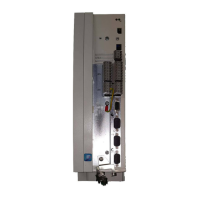Switching frequency of the inverter6.9
6.9−2
EDSVF9383V EN 7.1−04/2012
Codes for parameter setting
Code Possible settings IMPORTANT
No. Name Lenze Selection
C0018 fchop 6 Switching frequency of the
inverter
l General rule: The lower the
switching frequency the
– lower the power loss
– higher the noise generation
– better the concentricity
factor
l Observe derating indications
for high switching frequencies
l The max. output frequency
(f
max
) is:
– fchop = 4 kHz Þ
f
max
= 300 Hz
– fchop = 2 kHz Þ
f
max
= 150 Hz
– fchop = 1 kHz Þ
f
max
= 150 Hz
6.9−1
1 1 kHz sin loss−optimised
2 2 kHz sin concentricity−opti
mised
3 4 kHz f_top power−optimised
4 4 kHz sin noise−optimised
6 4/2 kHz sin noise/concentricit
y−optimised with
automatic
change−over to
low switching
frequency
C0144
OH switch 1
0 Switch off Switch−over is not
active
Temperature−dependent
switching frequency reduction
l If the heatsink temperature set
in C0122 is reached (warning
OH4), the controller switches
to 2 kHz
1 Switch on Switch−over is
active
C0144=0 (no temperature−dependent switching frequency reduction)
If the maximum permissible heatsink temperature (J
max
) is exceeded when
operating with automatic switching frequency reduction, the inverter is
inhibited, TRIP "OH" (overtemperature) is set and the motor coasts without
torque.
C0144=1 (temperature−dependent switching frequency reduction is
active):
ƒ If the heatsink temperature set in C0122 (overtemperature OH4) is
reached when operating with automatic switching frequency
reduction, the controller automatically reduces the switching
frequency to 2kHz, thus keeping the operation running.
ƒ After the heatsink has cooled down, the controller automatically
switches to the set switching frequency again.
Function of automatic
switching frequency
reduction

